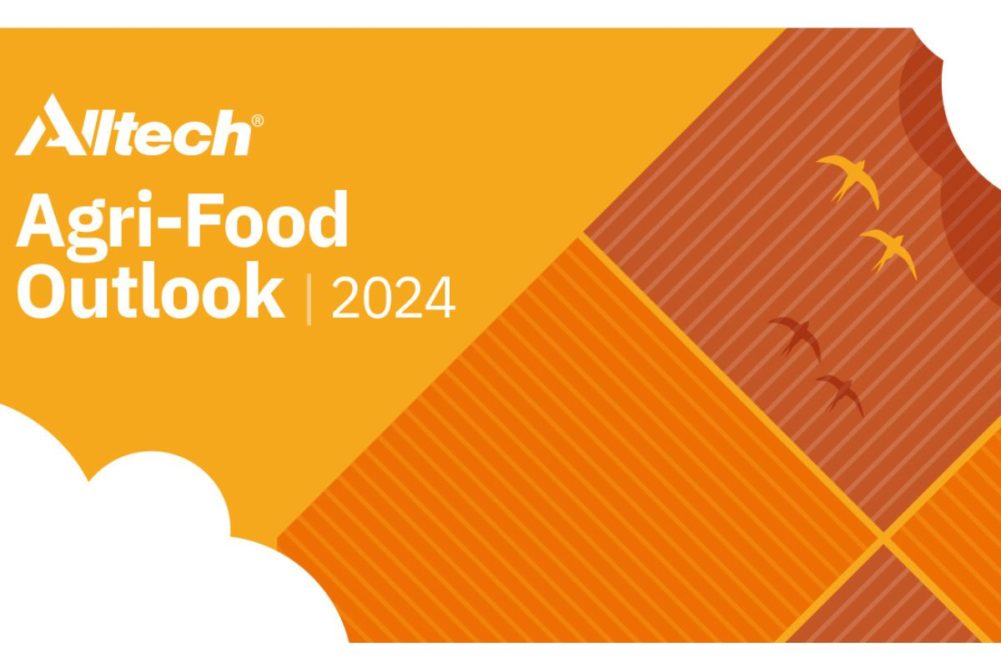LEXINGTON, KENTUCKY, US — Global animal feed production decreased slightly in 2023 to 1.29 billion tonnes, down 2.6 million tonnes, or 0.2%, from 2022’s estimates, according to the 2024 Agri-Food Outlook, released on April 2 by Alltech. The 13th annual survey includes data from 142 countries and more than 27,000 feed mills.
Alltech said the lower demand for feed was due, in part, to the more efficient use of feed made possible by intensive production systems that focus on using animal nutrition, farm management and other technologies to lower feed intake while producing the same amount of protein, or more.
A slowdown in the overall production of animal protein, in response to tight margins experienced by many feed and animal protein companies, also contributed to lower feed demand, Alltech said. Changing consumption patterns caused by inflation and dietary trends, higher production costs and geopolitical tensions also influenced feed production in 2023, the report noted.
The top 10 countries in terms of feed production in 2023 were:
- China (262.71 million tonnes, +0.76% over 2022)
- The United States (238.09 million tonnes, ‑1.13%)
- Brazil (83.32 million tonnes, +1.84%)
- India (52.83 million tonnes, +13.43%)
- Mexico (40.42 million tonnes, +0.02%)
- Russia (35.46 million tonnes, +3.83%)
- Spain (27.53 million tonnes, -11.88%)
- Vietnam (24.15 million tonnes, -9.63%)
- Japan (23.94 million tonnes, -1.15%)
- Turkey (23.37 million tonnes, -11.48%).
These countries produced 63.1% of the world’s feed production (same as in 2022), and almost half of the world’s global feed production is concentrated in four countries: China, the United States, Brazil and India, which had by far the largest increase in production among the top 10, Alltech said.
Asia-Pacific was the region with the biggest production growth last year, with an increase of 6.54 million tonnes (1.4%) boosting its world-leading total to 475.33 million. Latin America saw its feed output increase by 2.45 million tonnes (1.2%) to 200.6 million in 2023 despite high production costs, geopolitical tensions and changing consumer behavior due to economic reasons.
“The (Latin America) region continues to lead global growth, mainly because of its export-driven aquaculture, poultry and pork markets,” Alltech said.
Africa and Oceania also registered slight growth in feed output last year, with increases of 2% and 3.7%, respectively.
Europe continued its downward trend in feed production, declining 10 million tonnes (3.8%) year-on-year to 253.1 million due to issues that included the invasion of Ukraine and the spread of animal diseases such as African swine fever and avian influenza, Alltech said. North America saw a 1.1% decline to 259.2 million tonnes as beef tonnage decreased significantly. The Middle East saw a slight decrease of 120,000 tonnes to 35.93 million.
Beef feed production decreased by 4.36% (down 5.35 million tonnes to 117.49 million) globally — the most pronounced downward change among all species sectors last year, according to the report.
“Changes in cattle cycles in the United States and stricter sustainability policies in Europe had major impacts, with the Asia-Pacific beef sector notably surpassing Europe’s in 2023,” Alltech said.
Dairy feed tonnage decreased by 2.3% to 126.2 million tonnes, “primarily due to the high cost of feed combined with low milk prices, which led farmers to make strategic adjustments that included reducing their cow numbers and/or relying more on non-commercial feed sources.”
Also experiencing a decline was the global pig feed production sector, with a 1.2% decrease to 320.8 million tonnes, while aquaculture feed output also decreased, declining by 4.4% to 52 million tonnes.
Poultry experienced a 3.5% increase in broiler feed production to 385 million tonnes and remained steady with a slight increase for layers to 170.8 million tonnes.
To access more data and insights from the 2024 Alltech Agri-Food Outlook, including an interactive global map, visitwww.alltech.com/agri-food-outlook.




